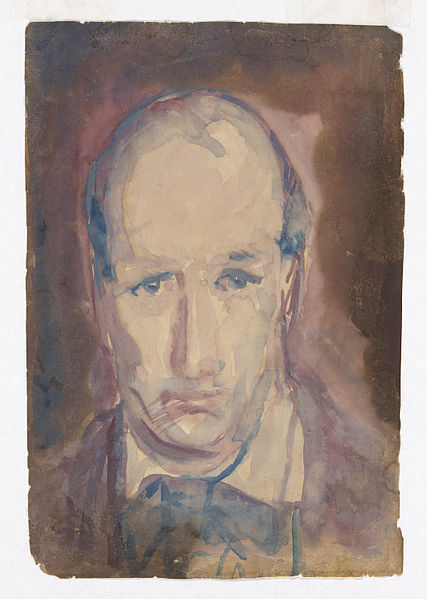
George Bellows,
Self-portrait, ca. 1921
watercolor
Yale University Art Gallery, Gift of George Hopper Fitch, B.A. 1932, in honor of Richard S. Field
George Bellows, 1882 – 1925
Self-portrait, ca. 1921
watercolor
Yale University Art Gallery, Gift of George Hopper Fitch, B.A. 1932, in honor of Richard S. Field
August 12 marks the 134th birthday of American painter and graphic artist George Bellows, an artist who played a vital role in the diverse and burgeoning ideas about contemporary art in the turn of the century. His work cut short by his untimely death in 1925, at age 42, Bellows’ oeuvre conjures questions about what he would have produced and innovated had he lived to the riper ages of some of his contemporaries, such as Edward Hopper (84), Rockwell Kent (88), and Charles Sheeler (81).
Often startling audiences with his themes of violence, the impoverished, and inner-city dilapidation, Bellows was unafraid to depict aspects of American life that were considered common or coarse by critics of his time. His painting Forty-two Kids (1907) was awarded a prestigious Lippincott prize by the Pennsylvania Academy of the Fine Arts annual exhibition, but was later denied the award, due to concerns about the continued support of the exhibition sponsors. The painting depicted a large group of semi-clad and nude young men engaged in youthful hijinks on a ramshackle wharf, talking, diving, swimming, smoking.

George Wesley Bellows, 1882 – 1925
“Forty-two Kids,” 1907
Oil on canvas
Corcoran Collection, National Gallery of Art, Washington, DC
Only a year later he accomplished The Stag at Sharkey’s and Both Members of This Club, both of which chronicled underground boxing matches with an unflinching portrayal of brutality and physicality. Although criticized for their violence, the paintings were also irresistibly compelling. Who was this inexperienced young artist who was able to grasp the American consciousness so quickly and with such spontaneous fluidity?

George Wesley Bellows, 1882-1925
The Stag at Sharkey’s, 1909
Oil on Canvas
Hinman B. Hurlbut Collection, The Cleveland Museum of Art, Cleveland, OH
Like so many self-made artists, George Bellows perceived his own artistic potential and sought it out. Although a successful baseball player at Ohio State University, he dropped out and left his hometown of Columbus to arrive in New York City in 1904, intent on beginning a career as an illustrator. He secured lodging at the Fifty-Seventh Street YMCA and enrolled at the New York School of Art. His earliest colleagues were destined to be his most important ones: Robert Henri, an influential and experienced teacher, and Emma Louise Story, his future wife and frequent subject of his later paintings. Henri encouraged his students to seek out contemporary subjects that would break the molds of conventional standards and tastes. Bellows was an attentive disciple of Henri’s realist doctrine, capturing both landscapes as well as ordinary people in gritty detail.
In particular, Excavation at Night (1908), in Crystal Bridges’ permanent collection (currently on view in the Museum’s Late Nineteenth-Century Gallery), captures the spirit of Bellows’s early works in the dark landscape, which records the construction of the 1910 Pennsylvania Station in New York City. The painting shows a city in transition, developing facilities to support its growth, and becoming the hub of modern culture and civilization that we know today.

George Wesley Bellows,
“Excavation at Night,” 1908
Oil on canvas
Crystal Bridges Museum of American Art, Bentonville, AR
Bellows played an important role in documenting this transition, capturing images that conveyed the workers and physical effort of building the city. Due in part to his efforts, this fleeting moment in history is preserved for future generations to view and appreciate as the US continues to develop and change both culturally and physically, just as it did during Bellows’s own life.
Read more about it!
!["George Bellows" Charles Brock, ed. Washington : National Gallery of Art ; New York : The Metropolitan Museum of Art ; London : Royal Academy of Arts ; Munich ; London ; New York : DelMonico Books/Prestel, [2012], ©2012](https://images.crystalbridges.org/uploads/2016/08/Bellows-book-cover-260x300.jpg)
“George Bellows”
Charles Brock, ed.
Washington : National Gallery of Art ; New York : The Metropolitan Museum of Art ; London : Royal Academy of Arts ; Munich ; London ; New York : DelMonico Books/Prestel, [2012], ©2012



